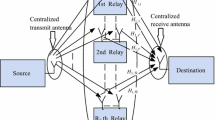Abstract
In Device-to-Device (D2D) communications of massive Multiple-Input Multiple-Output (MIMO) system, the inter-channel interference (ICI) can severely deteriorate the entire system performance. The beamforming technique can be used to alleviate this situation. Thus the localization of the users’ equipment (UE) should be known as a prior. In wireless communication, due to the effect of multipath, the model of incident signal should be regarded as distributed sources instead of point sources. In this paper, we propose a 2-D DOA estimation algorithm for coherently distributed (CD) sources based on conformal array. First, three rational invariance relationships are constructed based on generalized steering vectors (GSVs). Then the propagator method (PM) is used for estimating three rational invariance matrices. Finally, the 2-D DOA of CD sources can be obtained from the eigenvalues of three rational invariance matrices. Without spectrum peaking searching, and estimation and eigendecomposition of sampling covariance matrix, the proposed algorithm has low computational complexity. For the condition with a large amount of data, the distributed and parallel PM is proposed to deal with this problem. Simulation results verify the effectiveness of the proposed algorithm.








Similar content being viewed by others
References
Han G, Jiang J, Zhang C, Duong TQ, Guizani M, Karagiannidis G (2016) A Survey on mobile anchors assisted localization in wireless sensor networks. IEEE Commun Surveys Tuts. doi:10.1109/COMST.2016.2544751
Mach P, Becvar Z, Vanek Z (2015) In-band device-to-device communication in OFDMA cellular networks: a survey and challenges. IEEE Commun Surveys Tuts 17(4):1885–1922
Han G, Liu L, Jiang J, Shu L, Hancke G (2015) Analysis of energy-efficient connected target coverage algorithms for industrial wireless sensor networks. IEEE Trans Ind Informat. doi:10.1109/TII.2015.2513767
Asadi A, Wang Q, Mancuso V (2014) A survey on device-to-device communication in cellular networks. IEEE Commun Surveys Tuts 16(4):1801–1819
Ni Y, Jin S, Xu W, Matthaiou M, Shao S, Zhu H (2015) Beamforming and interference cancellation schemes for D2D communications. In: IEEE international conference on communication workshop (ICCW), pp 608–613
Marzetta TL (2010) Noncooperative cellular wireless with unlimited numbers of base station antennas. IEEE Trans Wireless Commun 9(11):3590–3600
Xu W, Liang L, Zhang H, Jin S, Li JCF, Lei M (2012) Performance enhanced transmission in device-to-device communications: beamforming or interference cancellation? In: IEEE Global communications conference (GLOBECOM), pp 4296– 4301
Wan L, Han G, Jiang J, Rodrigues JJPC, Feng N, Zhu T (2015) DOA estimation for coherently distributed sources considering circular and noncircular signals in massive MIMO systems. IEEE Syst J. doi:10.1109/JSYST.2015.2445052
Hu A, Lv T, Gao H, Zhang Z, Yang S (2014) An ESPRIT-based approach for 2D localization of incoherently distributed sources in massive MIMO systems. IEEE J Sel Top Signal Process 8(5):996–1011
Lv T, Tan F, Gao H, Yang S (2016) An ESPRIT-based approach for 2D localization of incoherently distributed sources in massive MIMO systems. Signal Process 121(C):30–45
Han G, Wan L, Shu L, Feng N (2015) Two novel DoA estimation approaches for real time assistant calibration system in future vehicle industrial. IEEE Syst J. doi:10.1109/JSYST.2015.2434822
Wang TD, Gan L, Wei P, Liao HS (2013) DOA estimation of coherently distributed sources based on block-sparse constraint with measurement matrix uncertainty. IEICE Electronics Express 10(6):1–8
Zhou L, Li G, Zheng Z, Yang X (2014) Parameter estimation of coherently distributed sources using sparse representation. In: Proceedings of IEEE China summit & international conference on signal and information processing (ChinaSIP), pp 577–581
Han G, Dong Y, Guo H, Shu L, Wu D (2014) Cross-layer optimized routing in wireless sensor networks with duty-cycle and energy harvesting. Wirel Commun Mob Comput 15(16):1957–1981
Lee J, Song I, Kwon H, Lee SR (2003) Low-complexity estimation of 2D DOA for coherently distributed sources. Signal Process 83(8):1789–1802
Guo X, Wan Q, Yang W, Lei X (2009) Low-complexity 2D coherently distributed sources decoupled DOAs estimation method. Science in China Series F: Information Sciences 52(5):835–842
Zheng Z, Li G, Teng Y (2012) 2D DOA estimator for multiple coherently distributed sources using modified propagator. Circuits Syst Signal Process 31(1):255–270
Zheng Z, Li G, Teng Y (2012) Simplified estimation of 2D DOA for coherently distributed sources. Wireless Pers Commun 62(4):907–922
Zhang G, Tang B (2008) Decoupled estimation of 2D DOA for coherently distributed sources using 3D matrix pencil method. EURASIP Journal on Advances in Signal Processing Article No 151
Feng N, Yue Y, Zhu C, Wan L, Liu QH (2015) Second-order PML: optimal choice of nth-order PML for truncating FDTD domains. J Comput Phys 285:71–83
Popa BI, Allen J, Cummer SA (2009) Conformal array design with transformation electromagnetics. J Comput Phys 94:244102
Liu L, Jiang Y, Wan L, Tian Z (2013) Beamforming of joint polarization-space matched filtering for conformal array. The Scientific World Journal Article ID 589675, 10
Zou Y, Xie H, Wan L, Han G (2015) High accuracy frequency and 2d-DOAs estimation of conformal array based on PARAFAC. Journal of Internet Technology 16(1):107–119
Li R, Xu L, Shi XW, Chen L, Cui CY (2012) Two-dimensional NC-music DOA estimation algorithm with a conformal cylindrical antenna array. J Electromagn Waves Appl 25(5-6):805–818
Zou Y, Xie H, Wan L, Han G, Li W (2015) 2D-DOA and mutual coupling estimation in vehicle communication system via conformal array. Mobile Information Systems Article ID 841341, 10
Qi ZS, Guo Y, Wang BH (2011) Blind direction-of-arrival estimation algorithm for conformal array antenna with respect to polarisation diversity. IET Microw Antennas Propag 5(4):433–442
Si WJ, Wan LT, Tian ZX (2013) Fast DOA estimation based on cylindrical conformal array antenna. Syst Eng Electron 35(8):1589–1595
Howland PE, Griffiths HD, Baker CJ (2008) Passive bistatic radar systems Bistatic radar: emerging technology. Wiley, New York
Acknowledgments
The work is supported by “Qing Lan Project” and “the National Natural Science Foundation of China under Grant No.61572172 and No.61602152” and supported by “the Fundamental Research Funds for the Central Universities, No.2016B10714 and No.2016B03114” and supported by “Science & Technology Pillar Program (Social development) of Changzhou Science and Technology Bureau, No.CE20165023”.
Author information
Authors and Affiliations
Corresponding author
Appendices
Appendix: The derivation of Eq. 18
Assume that the coordinate of each element is (x k , y k , z k ), k = 1, 2, ⋯, m. The unit vectors of X-axis, Y-axis and Z-axis are given by \({\overrightarrow {\mathbf {e}}_{x}},{\overrightarrow {\mathbf {e}}_{y}}\) and \({\overrightarrow {\mathbf {e}}_{z}}\), respectively. The position vector p k of kth element is expressed as
For sub-array 1 and sub-array 2, the elements are arranged on the same generatrix, the X-axis and Y-axis coordinates of the elements in the same generatrix have the relationship x 11 = ⋯ = x 1(m + 1) = x 1 and y 11 = ⋯ = y 1(m + 1) = y 1, respectively. The patterns of the elements in the same generatrix are identical as well, i.e., h 11 = ⋯ = h 1(m + 1). The kth element of the steering vector b 1(μ i ) of sub-array 1 can be expressed as
where the kth element of the steering vector of sub-array 1 is a 1k (𝜃,φ) = H 1 exp[−j l(k−1) cos𝜃] with
The azimuth and elevation DOAs can be expressed as
where 𝜃 i and φ i are nominal elevation and azimuth of ith CD source, and they are the means of 𝜃 and φ, respectively; \(\tilde \theta \) and \(\tilde \varphi \) are the corresponding random angular deviations. With the first order Taylor series approximation to a 1k (𝜃,φ) around (𝜃,φ)=(𝜃 i , φ i ), we can obtain
where \(\cos \tilde \theta \approx 1\) and \(\sin \tilde \theta \approx \tilde \theta \) are used in the first inequality for a small angular extension. Then Eq. 59 can be written as
where
The kth element of the steering vector b 2(μ i ) of sub-array 2 can be expressed as
For a small angular extension and d 1/λ = 1/4, it follows that \(\exp \left ({jl\tilde \theta \sin {\theta _{i}}} \right ) \approx 1\). Then b 2(μ i ) can be expressed as
Based on Eqs. 64 and 67, an approximate rotational invariance relationship between b 1(μ i ) and b 2(μ i ) can be given by
The derivation of Eqs. 24 and 25
For sub-array 3, the X-axis and Y-axis coordinates of the elements in the same generatrix have the relationship x 3(m + 3) = x 3(m + 4)⋯ = x 3(2m + 2) = x 3 and y 3(m + 3) = y 3(m + 4)⋯ = y 3(2m + 2) = y 3, respectively. The patterns of the elements in the same generatrix are identical as well, i.e., h 3(m + 3) = h 3(m + 4)⋯ = h 3(2m + 2). The kth element of the steering vector b 3(μ i ) of sub-array 3 can be expressed as
where \(\exp \left (- j\omega _{2i} \right ) = \exp [ - jl(\frac {1}{2}\sin \theta \cos \varphi + \frac {\sqrt {3}}{2}\sin \theta \sin \varphi )]\) according to Eqs. 8 and 11; the kth element of the steering vector of sub-array 1 is a 3k (𝜃,φ) = H 3 exp[−j l(k−1) cos𝜃] with
With the first order Taylor series approximation to \(\exp \left ({ - \frac {1}{2}jl\sin \theta \cos \varphi } \right )\) and \(\exp \left ({ - \frac {{\sqrt 3 }}{2}jl\sin \theta \sin \varphi } \right )\), we respectively have
and
For a small angular extension and d 2/λ = 1/4, it follows that \(\exp \left [ { - \frac {1}{2}jl\left ({\tilde \theta \cos {\theta _{i}}\cos {\varphi _{i}} - \tilde \varphi \sin {\varphi _{i}}\sin {\theta _{i}}} \right )} \right ] \approx 1\) and \(\exp \left [ { - \frac {{\sqrt 3 }}{2}jl\left ({\tilde \theta \cos {\theta _{i}}\sin {\varphi _{i}} + \tilde \varphi \cos {\varphi _{i}}\sin {\theta _{i}}} \right )} \right ] \approx 1\). The kth element of the steering vector b 3(μ i ) of sub-array 3 can be expressed as
Based on Eqs. 59 and 73, an approximate rotational invariance relationship between b 1(μ i ) and b 3(μ i ) can be given by
Similar as Eq. 74, an approximate rotational invariance relationship between b 1(μ i ) and b 4(μ i ) can be given by
where the form of H 4 is similar with that of H 3.
Rights and permissions
About this article
Cite this article
Wan, L., Han, G., Jiang, J. et al. A DOA Estimation Approach for Transmission Performance Guarantee in D2D Communication. Mobile Netw Appl 22, 998–1009 (2017). https://doi.org/10.1007/s11036-017-0820-2
Published:
Issue Date:
DOI: https://doi.org/10.1007/s11036-017-0820-2




